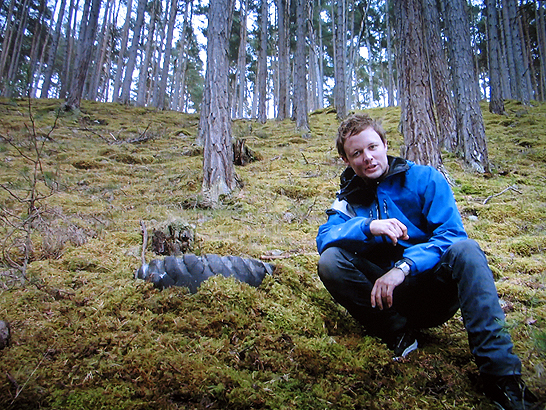
How did you get involved in the project?
I simply went to an audition and got the role quite easily (laughs).
But did you know what the film was going to be?
No, I had no idea. But I was pretty excited about the project and I really wanted the role… The fact that it looks like a documentary.
TrollHunter is unlike any other Norwegian film. Wasn’t that risky?
The risk is appreciable, and that’s what makes the job so exciting.
But compared to other successful films, such as FRITT VILT or SKJULT, the approach is totally different.
From the outset, the producer indicated that there was a market for such a film. The director went to the producer with just four sentences in his pocket, without a script. And that’s how the project came about, with Norway’s biggest producer today.
Looking at the box office, I was really amazed at the results, with a consistently high number of viewers going to see the film, week after week. The film was released on DVD and Blu ray in Norway on February 9, 2011, but was still in cinemas after that.
It’s very rare indeed. I’ve never experienced anything like it!
How did you work as an actor in such a format?
We favored improvisation, which is a very interesting method. Every take was different. Of course, we had the script, but we had to line up different dialogues each time. To keep the scenes authentic. In fact, we’d sit down with the director, discussing the scenes, what light would go with them. What the characters’ motivations were, where the scene was going, and we’d go from there. Sometimes this would take up to 25 minutes per scene, resulting in something totally unexpected.
And it works, because you seem to fit in well with all the other actors. The interactions are very natural.
Yes, we got on really well. It was also the director’s wish that we should feel connected to each other. Once I’d been selected, I was allowed to take part in the casting process with the director.
How did you feel playing in front of a green screen, with no interaction possible with what was about to be replaced by special effects?
I think it’s about using the imagination. It’s difficult, but that’s the actor’s job. Depending on certain scenes, we had to build fear, for example. As a result, I spent a lot of time alone in the woods, where it’s very scary (laughs). So afterwards, it wasn’t very difficult to be scared, thinking back on what I’d been through.
But did you already know what the trolls would look like?
No. We’d only seen drawings and knew they’d be about 15 metres high. That they’d look scary, but we didn’t know they’d have three heads! (laughs)
Indeed in all non-Scandinavian countries, trolls don’t have the same meaning or image as they do in your country. They’re a separate mythology. How do you think audiences will react to this?
Trolls are neither bad nor good, they simply exist. And they coexist in our world. The film has an informative side about troll mythology. There’s a lot in fairy tales. Like the fact that they smell the blood of Christians, that there are several types of troll… these are stories we know from our fairy tales. This is the first film to deal with them. Next time, we’ll know a little more.
Oh, so there’s going to be a sequel?
Chances are, yes.
It seemed pretty obvious to me, given the ending. But there was one thing that surprised me in this respect, which leaves a window open for a sequel.
The Prime Minister?
No, the character who arrives at the moment of the last hunt: the seismologist. Where did he come from?
It surprised me too.
If it comes out of nowhere like this, there must be a reason?
(mischievously) Maybe. I don’t know. But I can’t tell you! (Laughs) But there are opportunities, some offers from the States.
But that would lose something of its singularity. There are no trolls in the USA. It would become just another monster movie. You’ve succeeded in bringing a certain freshness, a novelty, a feeling for monsters.
Thank you. That’s good to hear. It’s true that I felt a certain sorrow for the great troll. The way you look at the monster at the beginning and at the end of the film is different.
Did you have a chance to contribute your own ideas about the character?
Yes, we developed the character with the director as we went along. He gave us a lot of freedom.
Did you enjoy working with André Øvredal?
Yes, a lot.
So you’ll probably still be working with him?
(smiles) Yes, if I get the chance…
I’m trying to get some information on what’s coming next… (laughs)
I got it! (laughs)
The film was a huge success in Norway.
Yes, absolutely huge. It was even named Norway’s biggest cultural event of 2010 by the country’s leading newspapers.
How did Norwegian audiences react to the film?
Audiences really took to the film and were very proud of it. It’s a typically Norwegian film in its themes and its approach to the subject. It was much appreciated.
So what’s next for you?
I’m also a filmmaker and have quite a few projects on the go. A TV series, a short film for the cinema and maybe a feature film, more of a drama.
Finally, what are your impressions of your presence here?
I love it! And the public is very demonstrative. It’s always good to see non-Norwegian viewers react to the film. There are a lot of nods to Norwegian culture, jokes… it’s reassuring to see that they’re also perceived by American audiences.
Notable differences between each audience?
Surprisingly little. The film really works everywhere!





